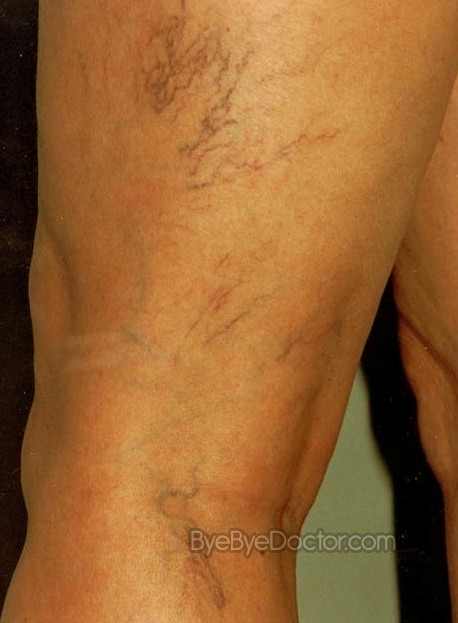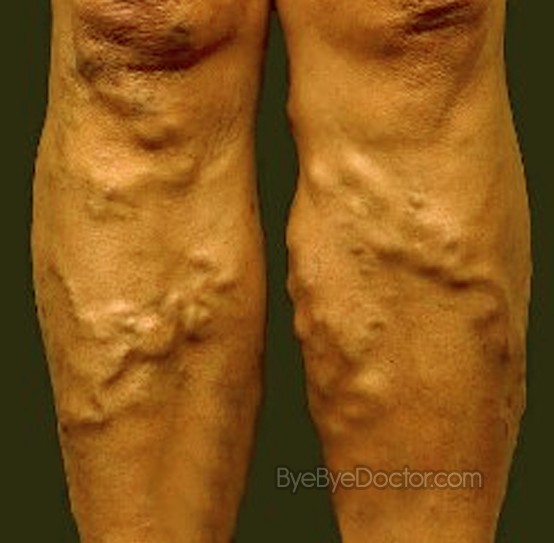Varicose Veins
Last reviewed by Dr.Mary on August 7th, 2018.
What are Varicose Veins?
Varicose veins are enlarged, gnarled veins. Any blood vein can become varicose, but the veins most often affected are the veins in the feet as well as the legs. That is simply due to walking and standing upright which increases the vein pressure in the lower part of the body.
For the majority of individuals, varicose veins as well as spider veins – a common, mild type of varicose veins – are mainly a concern cosmetically. For other individuals, varicose veins actually cause discomfort and aching pain. Often they lead to serious problems and they can also signal other higher hazard circulatory problems. The treatment can involve measures which are self-care or procedures by the doctor to remove or close the veins.
Varicose Veins Symptoms
Varicose veins normally do not create any pain. The signs and symptoms that indicate that an individual might have varicose veins are:
- Veins which are colored dark blue or purple
- Veins which appear bulging and twisted; resemble cords on the legs
- A throbbing or achy feeling in the legs
- Throbbing, burning, muscle cramping, as well as swelling in lower legs.
- Pain which is worse after standing or sitting for a lengthy period of time.
- Itching about most or only one of the veins
- Ulcers of the skin which are near the ankle, that can be an indication that this is a serious type of vascular illness that needs immediate medical attention
Veins known as spider veins are identical to varicose veins, except for the size which is smaller. They are usually located near the skin surface. Normally they are blue or red. They not only develop on the legs but also can occur on the face. Spider veins can differ in sizes as well as resembling spider webs.
There are self-care methods which can help with these veins – such as elevating the legs, exercise the legs or wear compression stockings which can help with any pain of varicose veins as well as stop them from becoming worse. If an individual is worried about how the veins feel and look, and the self-care help have not stopped the problems from becoming worse, a visit to the primary care physician is advised.
Varicose Veins Causes
Blood is moved from the heart to all the rest of the tissues thru arteries. This blood is returned from the body tissues to the heart by veins, so that this blood can be recirculated. In order to return this blood to the heart, these veins in the leg need to work against the gravity. Contractions in the muscle in the lower legs propel the blood and the elastic walls in the veins help to return the blood to the heart. There are miniature valves in the veins that open as the blood flows to the heart and then close in order to prevent blood from going backwards.
Reasons for varicose veins may include:
Age
As individuals get older, the veins may lose elasticity that causes the walls to stretch. The veins and the walls can become very weak, which allows the blood that needs to be moving in the direction of the heart to flow backwards. This causes blood to pool in the veins and the veins enlarge becoming varicose. The veins appear blue since they hold deoxygenated blood that is in the process of being recirculated thru the lungs.
Pregnancy
Many women who are pregnant develop varicose veins. Pregnancy raises the blood volume in the body, but decreases the blood flow from the legs to the pelvis. This change in the circulatory system is created in order to support the fetus that is growing, but it can cause a side effect which is unfortunate – veins in the legs enlarge. Varicose veins can surface for the very first time or can worsen during later pregnancies, when the uterus exerts pressure on the veins in the legs. Hormone changes during pregnancy may also play a role. These varicose veins which start during pregnancy normally improve without any treatment medically within 3 months after delivery.
There are rare complications of varicose veins but they can happen, and they can include:
Blood clots
Infrequently, the veins which are deep in the legs become enlarged. In these incidents, the leg which is affected can considerably swell. Any sudden swelling of the leg deserves medical attention which is urgent as it can be an indication of a blood clot – a condition referred to by the medical term thrombophlebitis.
Ulcers
Ulcers which are extremely painful can form on the skin near varicose veins, especially near the ankles. Long-term fluid buildup in the tissues can cause these ulcers by increased pressure of the blood within the affected veins. Any discolored spot on the skin is the usually sign before an ulcer forms. See a primary care physician if there is a suspicion that an ulcer is developing.
Varicose Veins Treatment
In order to diagnose varicose veins, the doctor will first do a physical examination which will include looking at the legs while the individual is standing in order to check for any swelling. The doctor may also ask for a description of any aching or pain that might be occurring in the legs.
The individual may need to have an ultrasound test in order to see if any of the valves in the leg veins are functioning routinely or if there is any evidence to suggest a blood clot. This is a non-invasive test where the individual lies on the exam table. A very small amount of gel which is warm is applied to the skin. This gel will help eliminate the forming of any air pockets between the body and the transducer. The technician, who has been trained in ultrasound imaging, presses a small device called a transducer which is hand-held about the size of a bar of soap. The transducer is pressed against the area of the body which is being examined, moved from one area to another as necessary. This transducer sends images of the veins in the legs to a monitor where the technician and the doctor are able to see them.
After a diagnosis is made or confirmed, treatment normally does not mean a stay in the hospital or even a long, sore recovery. This is due to the less invasive techniques which are currently used and allows varicose veins to be managed as an outpatient.
Self Care
This includes losing weight, exercising, not buying clothes which are too tight, keeping legs elevated and also avoiding setting or standing for extensive episodes of time. All of this can comfort pain as well as avoid varicose veins from possibly becoming worse.
Compression Stockings
Compression stockings should be worn as the first method of managing the problem of varicose veins before going on to any further treatments. These are stockings made to be worn from morning to night and they squeeze steadily the legs, helping the leg muscles as well as the veins move blood much more proficiently. The extent of compression will vary by brand and type.
Compression stockings are made in a wide assortment of strengths, colors and styles. With this much variety available, it is easy to discover a stocking which is fairly comfortable to wear.
These stockings can be bought at most drug stores/pharmacies as well as stores for medical suppplies. Prices may vary. Stockings which are prescription-strength are also available.
When buying these compression stockings it is important to make certain that they are properly fitted. They should be durable, but not unavoidably tight.
Other Treatments for Varicose Veins that is more-severe
If an individual is not responding to initial management techniques or if the condition is severe, the doctor might recommend one of the following treatments for varicose veins:
Sclerotherapy
With this procedure, the doctor will inject small to medium veins using a solution which marks and closes these veins. In several weeks, treated veins should have faded. The identical veins may need to be treated again, but still sclerotherapy is considered very effective when done properly. Sclerotherapy does not necessitate anesthesia and is performed in the doctor’s office.
Laser Treatments
Doctors using new knowledge for laser treatments can close off spider veins as well as smaller varicose veins. This works by transferring strong surges of light on the vein, causing the vein to fade slowly until gone. No needles or incisions are used.
Catheter-assisted techniques
These are treatments where the doctor inserts a tube which is thin into veins which are enlarged and the catheter tip is heated. While pulling the catheter out, the heat terminates the vein by initiating it to breakdown and seal shut.
Vein Stripping
A procedure involves removing a vein which is long thru small incisions and the procedure is usually done as an outpatient for many people. This will not affect the circulation in the leg because the veins deep in the leg can take over the moving of the higher volumes of blood.
Ambulatory Phlebectomy
With this procedure, the doctor eliminates smaller veins thru a sequence of tiny punctures of the skin. The portions of the leg which are being pricked are numbed in this procedure and is done in an out-patient setting. Scarring is usually negligible.
Endoscopic Vein Surgery
This is an operation used only in advanced cases which involve leg ulcers. The surgeon inserts a tiny video camera into the legs to visualize as well as close the varicose veins and remove the veins thru slight incisions. This therapy is also performed in an out-patient setting.
Varicose veins that occur while pregnant normally improve without any medical management within 3 months to one year following delivery.






